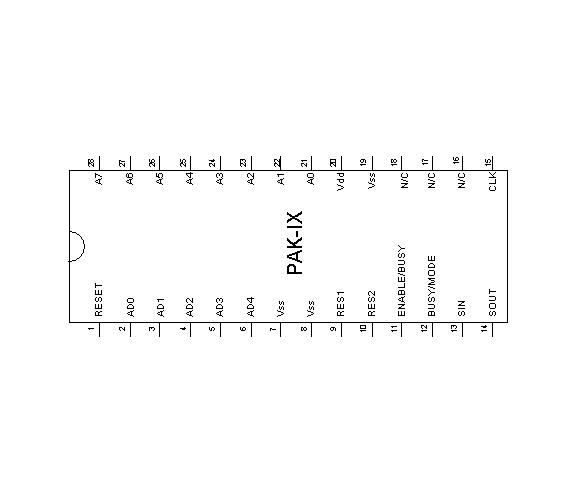
AWC Electronics - PAK-IX Document Addendum
The PAK-IX is very nearly the same as the PAK-II with a few exceptions.
1) Different pin out. You can find the pin out below. Note that the PAK-IX only has one digital I/O port, so the secondary port on the PAK-II is not available.
2) New Commands:
A2D (Command $29) - This command requires a single byte to be sent. The top 4 bits are the number of samples -1 (so 0 is 1 sample, %1111 is 16 samples). The bottom 4 bits indicate what channel to read (0-5). So to read 10 samples on channel 2, send $92. The command sums the samples and does a floating point divide, leaving the result in the X register. This command returns status (since it converts an integer to floating point).
A2DCONF (Command $28) - Send a single byte to configure the A/D converter. Send 0 (the default) to use all 5 channels as normal A/D inputs. Send 1 to set AN3 as Vref+ and 8 to set AN3 as Vref+ and AN2 to Vref-. This command does not return any value.
ESTO (Command $2A) - Store data registers to EEPROM. Note this does not include X and Y, but the registers you normally access via STO and RCL. Returns 0 (important since this command takes some time to execute).
ERCL (Command $2B) - Recalls data registers from EEPROM. This occurs automatically on reset. Returns 0 (important since this command takes some time to execute).
3) The SIN and other inputs are Schmitt triggers, which improves noise immunity. That also means you should use smaller pull up resistors (4.7K or less).
A/D Specifications:
10 bit resolution (0 to 1023)
Integral linearity error <+/- 1LSB
Differential linearity error <+/- 1LSB
Offset error <+/- 2LSB
Gain error <+/- 1LSB
External reference voltage range (Vref+ - Vref-): 2V - Vdd+0.3V
Vref+ range: Vdd-2.5V to Vdd+0.3V
Vref- range: Vss-0.3V to Vref+ - 2V
Input range: Vss-0.3V to Vref+ +0.3V
Source impedance <= 10K ohms

Site contents © 1997-2018 by AWC, Houston TX (281) 334-4341